The Nexus 7 (2013) Review
by Anand Lal Shimpi on August 22, 2013 6:00 PM ESTCPU Performance
The while the original Nexus 7 was fast for the money, the new Nexus 7 is just fast. Moving away from NVIDIA to Qualcomm, ASUS and Google settled on the APQ8064 Pro. Although we originally assumed this would be a quad-core Krait 200 based SoC, Brian's teardown revealed the part number 8064-1AA. What's special about that part number is it implies newer Krait 300 cores, making the SoC effectively a Snapdragon 600.
The CPU cores can run at up to 1.5GHz, putting it a bit lower than what we've seen from Snapdragon 600 based phones (e.g. HTC One tops out at 1.7GHz, while the US SGS4 hits 1.9GHz).
I was curious as to the impact of the lower frequency when combined with the potentially higher chassis TDP so I compared the Nexus 7 to the US Galaxy S 4. I turned to Geekbench because it offers a nicely woven mixture of single and multithreaded benchmarks, letting me look at peak available single core performance as well as what happens when multiple cores are active and working.
In this first graph we're looking at the first Krait 300 core running the workload. I've zoomed in to a small portion of the benchmark so we can get a better idea of CPU behavior:
The Nexus 7's CPU0 is almost always pegged at 1.5GHz whereas we see a lot of bursty thermal management on the smaller SGS4. This isn't unexpected, but what ends up happening is the sustained performance advantage drops from a peak theoretical max of 26% down to a more reasonable average gain of ~8%.
I was curious to see if multithreaded workloads showed any different behavior. Here we're looking at the fourth CPU core (CPU3). Note that it's not always active, which is why you see parts of the graph drop down to 0KHz. Once again we see similarly static behavior from the Nexus 7. Even with all four cores active, when you need the performance the Nexus 7 delivers a full 1.5GHz. These tests are short enough where we don't see tremendous swings in frequency, but once again we do see some frequency modulation in a smaller chassis.
The end result is that the Nexus 7's 1.5GHz Krait 300 cores are slower than what you'd get in a Galaxy S 4, however the gap isn't nearly as large as you'd expect it to be thanks to the larger chassis and how the platform is tuned. The Nexus 7 can run at 1.5GHz more consistently than Snapdragon 600 based phones can run at 1.7/1.9GHz.
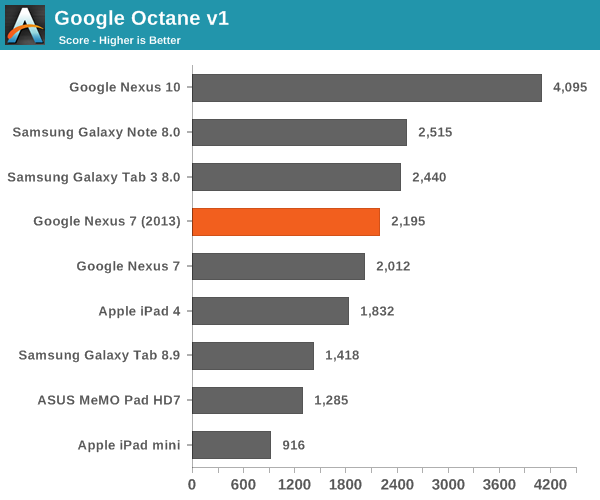


The GPU
Qualcomm seems to be frequency binning here, which is standard industry practice. Using binning to create these different SKUs gives Qualcomm pricing flexibility and also gives it the option to give large customers special treatment.
On the graphics side Qualcomm's Adreno 320 GPU makes an appearance. Clock speeds are also limited to 400MHz, compared to 450MHz for the high-end Snapdragon 600 implementations we've seen.
The APQ8064-1AA's dual-channel memory controller is populated with four x 16-bit DDR3L-1600 memory devices, giving the Nexus 7 a healthy amount of memory bandwidth. Peak memory bandwidth available to the APQ8064-1AA is 12.8GB/s, equalling what's available to Apple's A5X in the 3rd generation iPad with Retina display. Tons of memory bandwidth is obviously a pre-requisite for driving a high resolution display, and the combination of DDR3L-1600 and the Adreno 320 GPU delivers a butter smooth UI in all well written Android apps.
Although CPU performance is somewhat middle of the road compared to the rest of the landscape, GPU performance is faster than any other Nexus device on the market - and pretty much faster than any other similarly sized tablet:
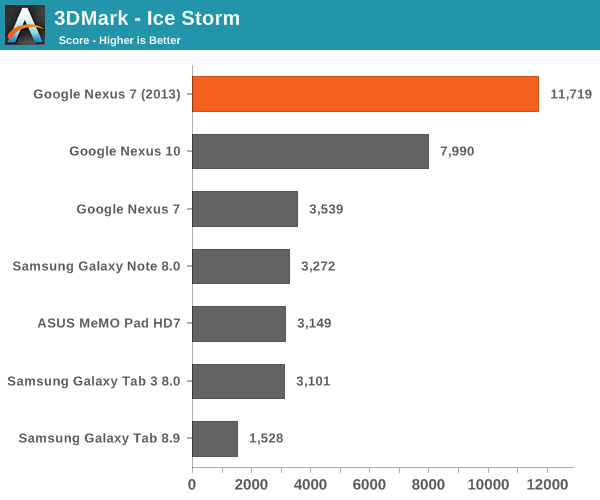
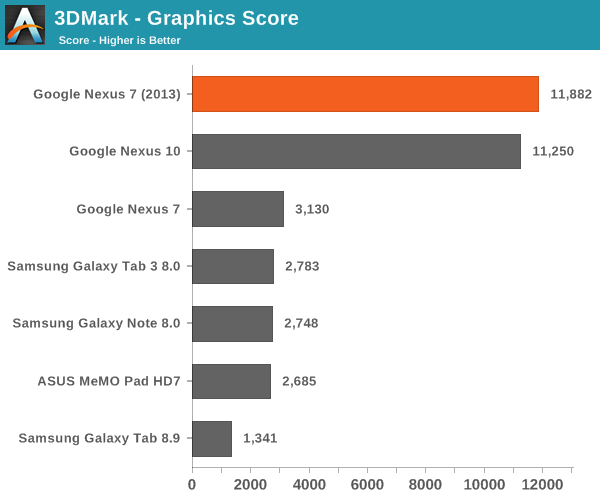
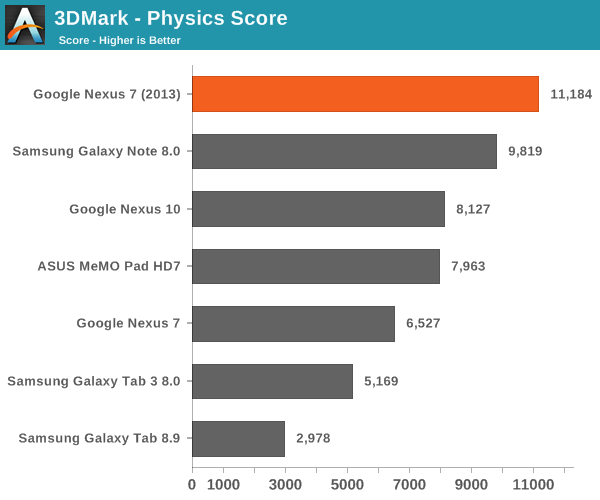
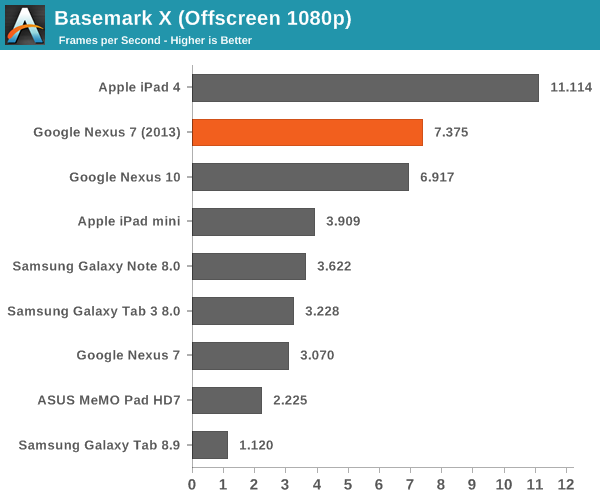
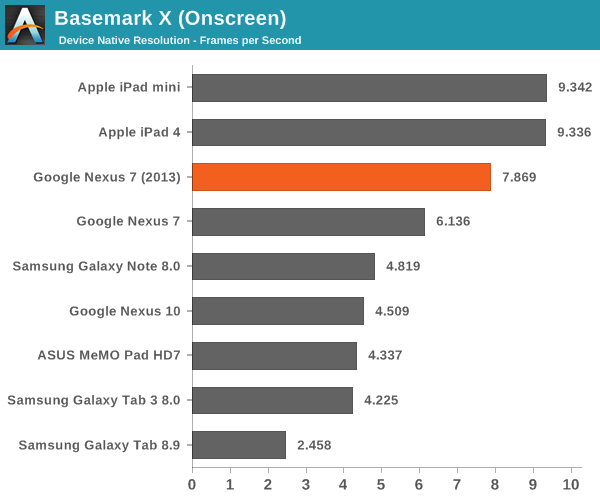
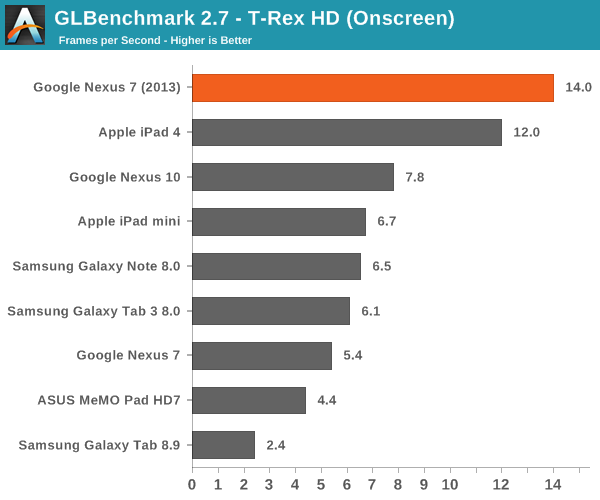
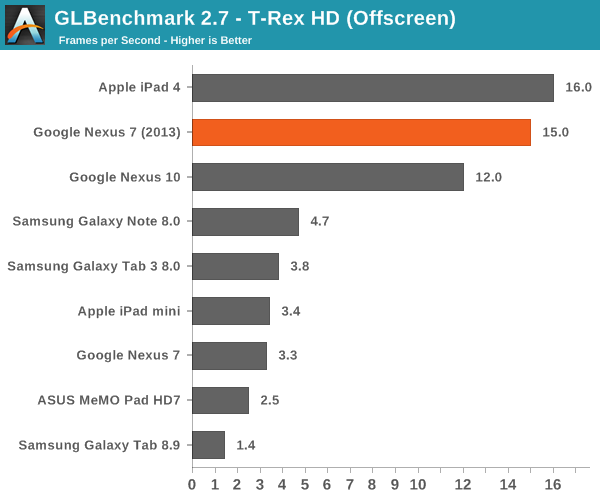
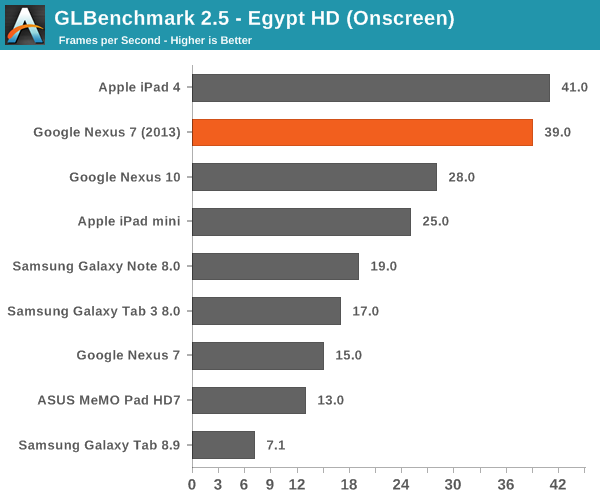
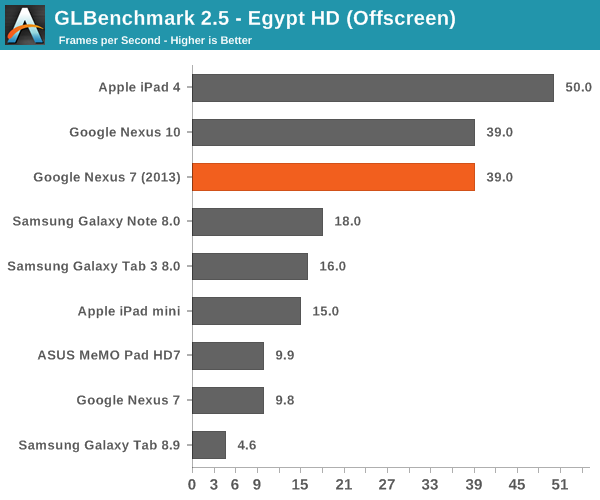
I played Modern Combat 4 as well as Shadowgun, both demanding 3D titles, on the new Nexus 7. Both titles appeared to render at the Nexus 7's native 1920 x 1200 resolution, and both appeared to do so at around 30 fps.


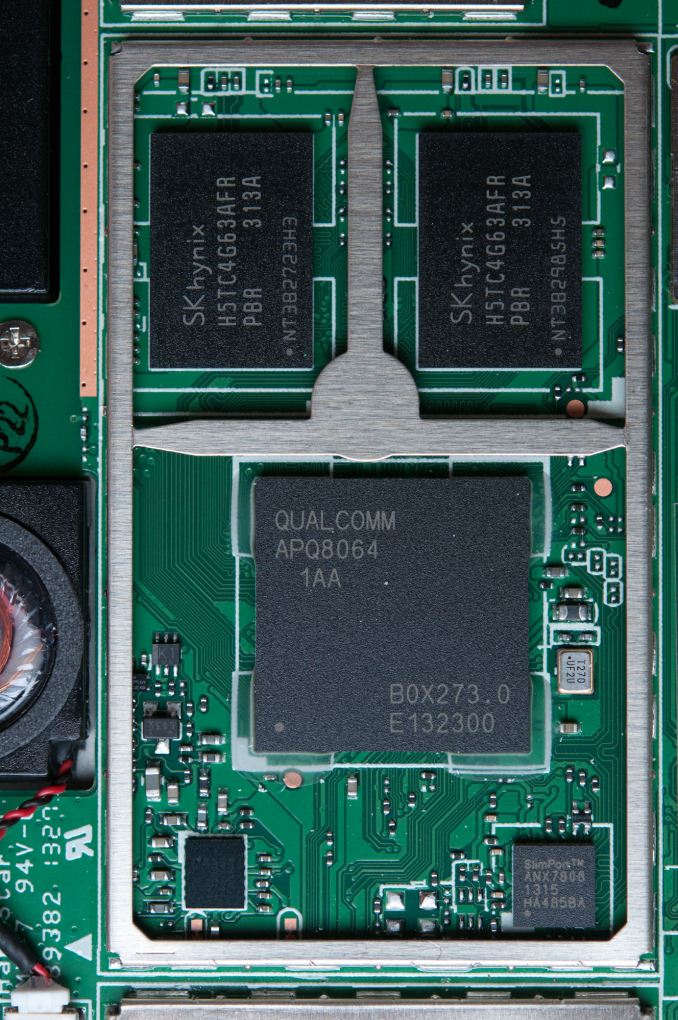
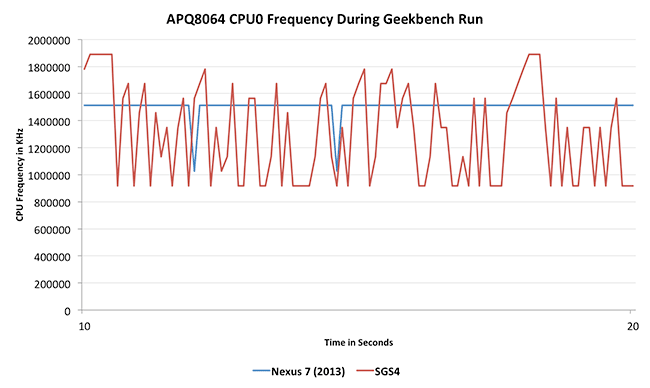
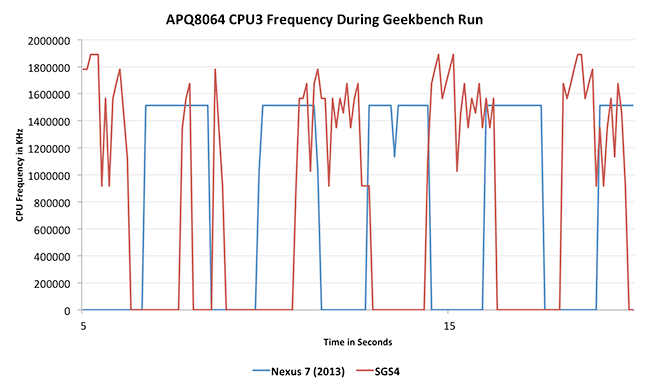








202 Comments
View All Comments
eio - Friday, August 23, 2013 - link
After playing with the new Nexus 7, I seriously think that equip the same 7" screen with a ultra-thin border (like Optimus G2) would be the ultimate form factor of smartphones. It won't be as comfortable to carry as a 5" but the enlarged screen size are much more beneficial for a portable computing device, which what smartphones are nowadays (imo they are not "phone" anymore, everyone is looking instead of talking to them). I can carry a 7" device in my back pocket without much problem, daily.meloz - Friday, August 23, 2013 - link
I so wish this tablet had a 9-inch screen. Then it would be perfect for me. 7-inch tablets do not work for me because of text size; you cannot hold them down (at lap level when sitting in chair) with the the wrists resting on legs. You always have to raise them up like a smartphone to chest height, and that gets tiring if you are sat and reading a long document/file.I wish Asus and Google would make a 9 inch variant of this device. :(
cjs150 - Friday, August 23, 2013 - link
Do what I did. Get a Nook HD+ and root it back to standard android. Although I would also strongly recommend getting a matt screen cover because of the reflections.Works really well as an e-book reader
ShieTar - Friday, August 23, 2013 - link
I just imported myself a Cube U30GT. Its a 10", but surprisingly enough they managed to keep it to 320g, so its as comfortable to hold as most 7" tablets. I can definitely hold it comfortably with one hand while operating the screen with the other one.aniym - Friday, August 23, 2013 - link
Since when did 659g become 320g? Seriously, this spamming of Chinese tablets is getting tiresome? Do you really think that readers of Anandtech, of all sites, are going to fall for your BS?meloz - Friday, August 23, 2013 - link
ShieTar, does your "Cube U30GT" (never head of it before, strange) posses identical specs and performance as the Nexus 7?Somehow I doubt it. I am not interested in disposable Chinese junk.
ShieTar - Monday, August 26, 2013 - link
Nope, it does most certainly not have identical specs and performances. The CPU is admittedly on the slow side, and the hardware is the kind of plastic you expect from a 200$ tablet. I did not try to tell you that it is better in every aspect then the Nexus 7, I merely expected that your reason for wanting a 9" when there is already a ton of 10" devices would be weight, and I offered a comment on that topic.ASEdouardD - Saturday, August 24, 2013 - link
Yeah, it'S 670 g. Way more than 320. Also, I'd stay for away from cheap Chinese tablets for now. Tablets are computers. So many things can go wrong, I have to really trust the company I'm buying this from. I'm sure China (and hey, I don't consider Taiwan part of China) will get there soon and produce high quality tablets, but we're not there yet. Anyway all Android tablets are crap except the Nexus line anyway.ASEdouardD - Saturday, August 24, 2013 - link
To each his own. I feel 7 inch is the best size for me. I find even the iPad Mini too big to carry around a lot. The iPad 4 and the Nexus 10 are just way too big for that. They're more couch tablets then follow you everywhere tablets. I don't even realize I'm carrying around my new Nexus 7 in my man purse (it's European!) because it's so light and small.ASEdouardD - Saturday, August 24, 2013 - link
''than''. Sorry.